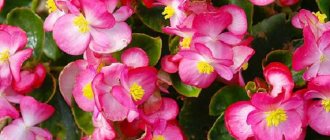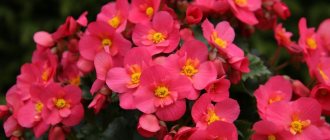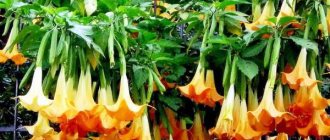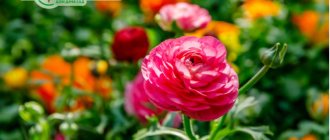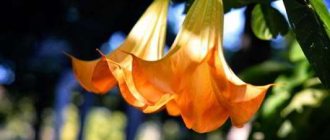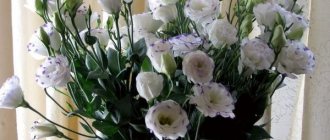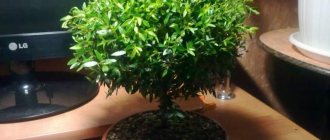general characteristics
Begonia received its name in honor of Michel Begon, a famous botanist and quartermaster of the French fleet. This is a large and diverse family, so the varieties differ significantly from each other: herbaceous and bushy, semi-bushy, creeping, tuberous, annual and perennial.
Separately, there are decorative species, notable for their large bright flowers. And separately - deciduous, with rich bright foliage in rich colors. The stems of bushy varieties resemble bamboo. They are resilient and erect. In creeping begonias they are thin and flexible. Rhizomatous ones are thick and mundane. Beautifully flowering begonias are mainly grown in gardens.
Photo: zulminakr.ru
Types of begonia
There is no single generally accepted classification of begonias. They are divided by appearance, by the type of rhizome, type of stems, and by growing in pots or open ground.
Royal begonia
A leafy variety native to India is considered one of the most beautiful among all the hundreds and thousands of varieties. It's all about the spectacular leaves of unusual color: crimson, bronze, violet-scarlet. Their size reaches 20x30 cm.
The surface is spotted, with veins and complex transitions. There are hybrid forms with almost black plates. But the flowers of the Royal Begonia are unremarkable. They are small and rather inconspicuous.
Photo: flo.discus-club.ru
Caroline begonia
This is one of the most unusual and at the same time most domestic varieties; it came from Mexico. Wide creeping shoots are covered with original palmately dissected elongated leaves with jagged edges and pronounced veins.
Flowers are collected in loose inflorescences. They are quite pale, pinkish-green, but look very interesting against the background of rich foliage.
Photo: panoss.fotki.com
Tiger begonia
The Mexican variety got its name due to the characteristic color of the leaves. The plates themselves are pale green, but dark spots-stripes radiate from the veins.
Tiger begonia are low shrubs with creeping stems. It is absolutely decorative and is almost never found in the wild.
Photo: all-begonias-tamaravn.blogspot.com
Coral begonia
The species received its name for the delicate coral shade of peduncles and inflorescences collected in a brush. This is a Brazilian subshrub that, under favorable conditions, can grow up to a meter. The shoots are tough and erect.
The front side of the leaves is dark with silver spots, and the back is pale. The plate itself is of an elongated, pointed shape.
Photo: greenfreelance.ru
Everblooming begonia
This is the most popular garden variety of begonias in the form of a neat small bush up to half a meter. The plant acquires this form over time. Young shoots are erect.
The leaves are round, dense, bright and with a little fluff. Most often they are dark, deep green, but sometimes they are pale and reddish.
Depending on the variety, the flowers can be regular or double. They quickly fade, but are almost instantly replaced by new ones, so this begonia can bloom all year round.
Photo: forumodua.com
Ampelous begonia
Ampelous begonia is the queen of arches, balconies and terraces. It grows in picturesque hanging cascades and is grown in baskets or flowerpots.
Shades of flowers - almost any, in white-red-yellow tones. They can be of different sizes and textures, from smooth to dense.
Photo: waysi.ru
Begonia Elatior
This is a delicate and graceful hybrid, ideal for home seedlings. It pleases with its abundant and frequent flowering, compact size and neat appearance of the bush.
Small, up to 8 cm, heart-shaped leaves grow on fleshy shoots. Their front side is shiny, and the back is matte, almost velvety.
Photo: 2sotki.ru
Coleus (60 photos): types and features of care
Popular varieties
Begonia flower - propagation at home
Terry begonia varieties are divided into two large groups:
- bush begonia. Used for decorative purposes, when landscaping open areas;
- Tuberous begonia is the best option for indoor floriculture.
In domestic ornamental gardening, it is customary to distinguish the following varieties of begonias:
- foliage and decorative;
- decorative flowering.
Decorative deciduous varieties are characterized by unusually brightly colored foliage. The flowers are almost invisible against the background of enchanting leaves. Such begonias are used for landscaping and creating the structure of the garden.
The largest number of terry begonias among the last three varieties. Below are more details about some of them.
Begonia fragrant
The flowers of this series are characterized by a pleasant subtle aroma and ruffled lush flowers. There are several color options:
Red Glory - the bright red flowers of this variety are always visible from afar.
Red Glory
Sunrise with orange aroma and color. They attract butterflies and bees, enlivening the garden space.
Sunrise
White Angelica is a white double begonia. The flowers look like white and pink foam.
White Angelica
Begonia fringed
The flowers are similar in terry edges to large lush carnations. There are many varieties: salmon, orange, red fringed.
Fringed species
Ampelous begonia
A popular group of varieties ideal for vertical gardening. A distinctive feature is the long hanging stems. Notable flowers range from simple to double, with various color variations.
Ampel variety
Fiona
Delicate transparent pink flowers with double petals. Looks great in the garden. The buds are not prone to fading. There is a variety with light orange flowers. It has dark green large leaves. There are annual and ever-flowering subspecies.
Variety Fiona
Quinn
Perennial begonia. The best option for large flowerpots and rooms. The variety has half-open flowers of red, white, pink, and orange.
Queen variety
Yellow
Designed to create accents. It looks as if the sun has fallen into the garden. Large double flowers of bright yellow color and dark green medium-sized leaves are pleasing to the eye. Grow in spacious pots.
Variety Yellow
Fire coral
An annual variety with heavily double flowers. Buds with transitions of orange-coral-scarlet color. The effect of a fiery flower is created.
Variety Fire Coral
Begonia care
Begonia is quite unpretentious, but it needs stability. This is the only way the flower really reveals itself in all its glory. Flowering varieties can delight with a riot of colors throughout the year. And lush and lush deciduous species look luxurious in green corners.
Temperature
Begonia is a heat-loving plant. In summer, she feels best at a temperature of 20-23 degrees. In winter, do not allow hypothermia below 15-16.
Due to their love for tropical climates, flowers need moisture. But spraying the leaves is not recommended. This causes them to deteriorate and become stained.
Use an air humidifier or an additional tray filled with wet expanded clay. This way the begonia will have enough moisture and the root system will remain safe.
Photo: themarthablog.com
Lighting
The more sunlight, the better. Especially for brightly flowering species. But remember that begonia leaves are delicate. Shade them from too aggressive direct rays.
But deciduous varieties are not so demanding - diffused light from eastern or western windows is enough for them.
Photo: themarthablog.com
Watering
Begonia needs abundant watering. Especially in hot summer. But don’t let the water stagnate: more often is better, but less. Before watering again, wait until the top layer of soil dries out. Use only distilled water.
In winter, begonia is dormant, so watering is reduced. And tuberous varieties even go dormant. They need to be placed in peat and not touched at all.
Photo: felisov.ru
Fertilizers and fertilizing
Fertilizers need to be applied when the begonia has already bloomed. It takes a lot of resources to support such beauty. Use additives and admixtures once every 2 weeks after the first flowers appear. Just keep in mind that mixtures with nitrogen are only suitable for deciduous species.
Photo: 2sotki.ru
Trimming
To form a lush crown, begonia needs to be periodically pruned. Start at the young flower stage. Just periodically cut off the top, this stimulates the growth of side branches.
In the future, repeat the procedure as necessary. Trim only dry or overgrown stems. If you want, the begonia crown can be shaped - then pruning is done based on the desired result.
Photo: sdelai-lestnicu.ru
Lighting
Decorative begonias love sunlight and will delight you with their picturesque colors when you place them on a south-facing window.
It is advisable to grow flowering begonias at home on windows in eastern and western directions.
Begonias love freedom and even illumination; when placing them next to other plants, leave space between them. Make sure that neighbors do not shade the flower, otherwise it will suffer.
In autumn-winter, compensate for the lack of lighting with special lamps.
Planting and propagation
Begonia is propagated by all standard methods: division, cuttings and stems. But different species have their own nuances. Be sure to familiarize yourself with them in advance, otherwise the begonia will not bloom.
It's easiest with tuberous varieties. It is enough to trim, separate and replant the tubers in the sand mixture in February-May. Just keep in mind that they germinate and take root slowly. Any soil mixture for deciduous plants is suitable for planting begonias. She is not demanding in this matter. There is no need for regular transplantation. This must be done as the flower grows, so that the root system is comfortable in the flowerpot.
Photo: whiteflowerfarm.com
Photo: asienda.ru
Tradescantia (60 photos): types and features of care
Top dressing
The domestic Begonia plant loves fertilizers and will thank you with abundant and bright flowering. It is recommended from mid-spring to mid-autumn to water the plants once every two weeks with a mineral-vitamin complex for flowering plants.
In specialized stores you can choose a suitable complex for your plants. For flowering species, choose phosphorus-potassium fertilizers; for decorative deciduous species, fertilizers with a high nitrogen content are suitable.
From November to March, flower fertilization should be stopped and begonias should not be prevented from resting before the next blooming year.
Pest and disease control
The set of typical begonia problems is standard for deciduous flowering plants.
— Excess moisture causes fungal diseases and powdery mildew. Check the core of the bush, usually the problem starts there. For treatment, remove all damaged fragments, reduce watering and treat the flower with antifungal drugs;
— The most common parasites are aphids and spider mites. To combat them, use classic insecticides;
Photo: outlawgarden.blogspot.com
— If the begonia does not bloom or the buds fall off, it is most likely cold, windy or lacking light. Try to change the place and not be overzealous with feeding;
— Yellowing leaves mean that the begonia does not have enough moisture or fertilizer. Sometimes this is a symptom of pests that are destroying the roots. Then you need to clean the rhizome, disinfect it with potassium permanganate and transplant the flower into new soil.
Photo: sup-kartoshka.ru
Possible difficulties during cultivation
- Direct sun exposure to leaves may cause burns in the form of brown or copper-colored spots.
- Dry leaf edges are caused by too dry air.
- Water getting on leaves can cause fungal diseases.
- Overdrying the soil, especially in hot weather, can contribute to powdery mildew.
- Excess fertilizer causes leaves to curl and change color.
- Overwatering, especially in combination with hypothermia, causes wilting and death of the plant. Rotting of the base of the stem is often observed.
- Lack of light causes elongation of shoots, lack of flowering, and yellowing of leaves.
- Avoid direct cold drafts and do not place the plant near heating appliances, air conditioning or humidifiers.
Begonia – photo
Several photos are unable to convey all the beauty and diversity of begonia species. But we have put together this collection for inspiration and are happy to share it with you!
Photo: elblogdelatabla.com
Photo: hammer-shop.ru
Photo: steemit.com
Photo: pinterest.com
Photo: worldoffloweringplants.com
Photo: 2sotki.ru
Photo: 2sotki.ru
Photo: thefunbank.blogspot.com
Photo: fotostrana.ru
Photo: nixpixmix.blogspot.com
Photo: all-begonias-tamaravn.blogspot.com
Photo: 2gis.ru
Photo: mykaleidoscope.ru
Photo: oir.mobi
Photo: mykaleidoscope.ru
Photo: balkonpflanzen-pflege.de
Photo: entromax-ic.ru
Photo: love-flowers.rf
Photo: 2sotki.ru
Photo: botanichka.ru
Photo: 2sotki.ru
Photo: plantkiller.wordpress.com
Photo: flo.discus-club.ru
Photo: agbina.ru
Photo: rachelwilliamsonline.com
Photo: flori-da.ru
Photo: safenetvoice.org
Photo: dkvitin.ru
Photo: krsk.au.ru
Home cacti (95 photos): types, care features
